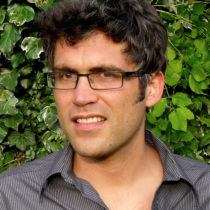Landscape Architecture for Landscape Architects › Forums › RESEARCH › How to masterplan a multi-purpose orphanage/school facilitiy?
- This topic has 1 reply, 10 voices, and was last updated 12 years, 11 months ago by
 Thomas J. Johnson.
Thomas J. Johnson.
-
AuthorPosts
-
December 9, 2010 at 4:44 pm #166462
 Alex KarapatisParticipant
Alex KarapatisParticipantHi everyone,
I am collaborating with a team of LA’s, architects, and engineers to masterplan a multi-purpose orphanage/school facility in Pakistan for communities affected by the 2005 earthquake and would appreciate some input from the LA community. Do you know of any sources either from books, the net, or existing designs that suggest ideas, case studies, examples and/or guidelines that would assist in developing a materplan with a strong community ethic?
One of our initial concepts is to approach it as a traditional campus design i.e buildings arranged around recreational greenspace. What is everyones opinion of such an approach and can alternatives be suggested?
The masterplan will include a school (400+ children), orphanage (200+ children), 4 religious buildings (mosque, church, and 2 temples), a storage warehouse, a textile production facility for orphans to obtain work-expereince in order to transition into the real-world (i have been assured that this will be entirely ethical), 2 accomodation buildings for staff. a petting zoo, football and recreation fields, community gardens/allotments, and a generous quantity of outdoor space to stitch the whole thing together.
Any links to existing projects, publications, blogs, books etc would be much appreciated. Internet accessible info is preferable but info on books will still helpful.
Much thanks for your time, I look forward to hearing your suggestions,
Alex
December 9, 2010 at 5:58 pm #166479 Thomas J. JohnsonParticipant
Thomas J. JohnsonParticipantWhen I was a kid, I loved building “forts” out of cardboard boxes, blankets, tarps, old mattresses, crawl spaces… you name it. The peak of my pre-pubescent architectural career was a “fort” created from scraps salvaged from a neighbors bathroom renovation. It’s bones were pallets covered with a tarp (for water proofing) and scraps of plywood (for aesthetics and to anchor the tarp). Perched on top of a hill, thick with old-growth burr oaks, it had a shower door (laid horizontal) as the wall overlooking the woods. It had a working fire-place (heating duct backed by tile for fire protection) and a pallet rooftop deck. You could walk on the roof and one pallet cantilevered over the slope, there was a rope swing with an old skateboard deck attached to the bottom that you could stand on the edge of the pallet like you were dropping into a half-pipe but instead of dropping into a ramp, you would drop-in and swing out over the abyss. I remember telling my dad about the skateboard/rope-swing idea one night and he proceeded to got out and climb the tree that very moment, in the dark, in the rain, no doubt with a few Budweisers in his system, as was par for the course. He must have scrambled 20′ or more into that tree, pouring rain be damned and as the knot master he was, tied the perfect rope-swing hanging knot. It was a sight to behold… 300 lb man, 20′ off the deck, in the rain, tying a knot out on a limb never intended for big men. Epic. Awesome. Thanks Dad! You could have waited until it was nice out, but it probably wouldn’t have been as memorable.
OK, so whats the point of my ramble? Instead of dictating the kids living conditions. Let the kids decide… kids that live in a world with no control (orphans) need a place to call their own. I like the idea of a centralized play area, perhaps you could use a “cottage” model or base the structures off of what their traditional homes are like, then give them a lot of “stuff” to make it their own… kids don’t need much to entertain themselves and having a creative outlet and the ability to influence their space could prove to be beneficial to them in the long run. If you want to make it a truly memorable experience, do something crazy-cool… that they can participate in…
Hope that helps…
December 9, 2010 at 7:07 pm #166478 Theodore TegenParticipant
Theodore TegenParticipantMy initial reaction is that the “campus mall” type layout would too closely reflect a prison yard, something a orphaned child does not need. Before doing any research into master plan design for the structures you outlined, I would first develop a very clear understanding of Pakistani culture for the region in which you are designing. Nothing says ignorant foreigner more than a design that ignores cultural values and norms of the intended user.
Side note: Though the textile production training facility is promised to be run ethically, the bottom line is these children are being trained to prepare for life in a (probably an unethically run) sweatshop when they are old enough? Yikes…
December 9, 2010 at 7:22 pm #166477 Wyatt Thompson, PLAParticipant
Wyatt Thompson, PLAParticipantWhat I’m about to suggest may lead you off in a totally wrong direction given your situation, so be careful, but you should check out the resources at Architecture for Humanity. Cameron Sinclair also has a book called Design Like You Give a Damn. Great book, incidentally. While the end users described in these works are largely political and environmental refugees in the immediate aftermath of a disaster, you might find some interesting case studies on adapting to local socio-cultural norms and the use of local materials and construction methods. And, given our own experience with Hurricane Katrina, 5 years may still be an immediate aftermath.
Re: Thomas’ suggestion: LAM did a story several years ago (4-5 maybe?) about an LA working with kids to design their own school compound. (Sorry I can’t remember any of the details about who or where it was.)
December 9, 2010 at 7:27 pm #166476 Thomas J. JohnsonParticipant
Thomas J. JohnsonParticipantWas it Ken Smith, in NY, when he used the rolling dumpsters as planters?
December 9, 2010 at 7:28 pm #166475 Thomas J. JohnsonParticipant
Thomas J. JohnsonParticipantWorking in a sweatshop might be better than starving to death… depending on your perspective.
December 9, 2010 at 7:42 pm #166474 Wyatt Thompson, PLAParticipant
Wyatt Thompson, PLAParticipantThat’s not what I was thinking of, but I’m sure there are lots of similar examples of working directly with the end users. That’s the planning model that Project for Public Spaces (http://www.pps.org) uses in all their work. For that matter, I’ve master planned a park with the help of 5th & 6th graders at a neighboring school. LAM didn’t come interview me about it though. 🙁 In the example I’m thinking of, the prime LA was a woman, and the project she was working on was overseas. I’m sure that narrows it down!
December 9, 2010 at 7:56 pm #166473 Gabrielle NewmarkParticipant
Gabrielle NewmarkParticipantI was going to the forums to look for soil structure info for the LARE and came across your posting.
I used to work primarily with non-profit organizations in Los Angeles on community based greening project – everything from sustainable school layouts to streetscape projects. On all of these projects I worked with the people in these specific communities – all have had real social issues- -within these project settings I have worked with youth in gangs, foster children, and the list goes on. I have also -on my own- built a garden in a school in Peru with children living in poor conditions and orphanages.
All this said- I have not worked in Pakistan but I do know that working in these types of settings the best thing to do is actually work with the communities that you are building in and set up charrettes with the children that you are going to be building for. They need to have a say in the process and feel like they are a part of the process. By directing the design chareette in an a sensible but empowering way you can get great ideas from people that are living in their community and who know their culture instead of outsiders trying to force design on the land and the community. just my two cents. . . back to studying.
December 9, 2010 at 8:16 pm #166472 Alex KarapatisParticipant
Alex KarapatisParticipantHey guys,
Thanks for all your input. Tom’s comment makes me realize a bit more background on the project might be required. This project is about two years old and runs entirely on volunteered time. So we have a situation where all the buidlings have been individually designed (pro bono) by different architecture firms, without any cohesive masterplanning. The current situation requires an element of reverse engineering to deliver a master plan from the existing layout/footprints of these buildings, not ideal but that is where the project currently is.
I personally have a very strong affinity with Tom’s suggestion, being a young builder of forts myself. While such a concept may be unsuitable to drive the whole masterplan it makes a lot of sense as a suggestion for personalizing the outdoor areas.
Theodore, i can see your point about training children for future sweat shop employment. But i think it is necessary to see the philanthropic intention behind the proposal. In order to provide assistance to the greatest number of affected youths the intention is to reintegrate orphans back into society once they have attained adulthood, freeing up space to assist younger orphans. One possible method is to give educated, adult youths the necessary work experience to obtain employment outside of the orphanage. This is of course only one of many methods, but one that has a model of success in a developing countries such as Pakistan.
Wyatt, i will certainly check out those links, and Tom, it was indeed Ken Smith who used the rolling dumpsters as planters.
Keep the comments and suggestions coming, any relevant books, articles, journals, and/or website recommendations will be very much appreciated.
December 9, 2010 at 9:17 pm #166471 Thomas J. JohnsonParticipant
Thomas J. JohnsonParticipantWhen I hear “woman over seas” I think “Gustafson”, but that doesn’t really help…
December 9, 2010 at 9:19 pm #166470 Thomas J. JohnsonParticipant
Thomas J. JohnsonParticipantDo you have all of the building footprints and the site base? If you want to forward them to me, I’ll see what I can come up with… speaking of your thread about being unemployed and keeping your skills sharp…
December 10, 2010 at 3:33 am #166469 Heather SmithParticipant
Heather SmithParticipantThis whole thing seems weird to me. Orphans gaining work experience and a petting zoo. It sounds like putting someone is trying to put window dressings on something ugly here. If something is philanthropic so be it…but educating them for the “real world”?
Off of that little tangent…my first thought was of course cultural relevance but since the footprints are already there that is a tough one. Where do these orphans come from? What part of Pakistan? What are the safety issues either from the Taliban or from issues with India…heck what about drones from the U.S.? I think my questions would be much more about the safety of the children…is this a secure part of Pakistan? And why so many different religious buildings? Are they shipping in children from all over? I know there are many religions just wonder about quantities filling four separate religious buildings. I certainly hope they took lay-out in consideration for that.
Honestly, I think this thing smells fishy. If someone wants to provide jobs to young children they should just come out and say it. I think some company is getting free work from a bunch of Westerners that have no idea they are being duped. I could be reading into this and forgive me if I am…I am just very skeptical of essentially a compound that entails hundreds of children living where they work.
December 10, 2010 at 6:42 pm #166468 Elizabeth RentonParticipant
Elizabeth RentonParticipantI bet the article may have been referencing landscape architect Robin Moore, and his work with the Natural Learning Initiative. He’s a well-known designer of outdoor children’s spaces and he ALWAYS advocates that the children should be involved in the design process. He co-authored a book, Natural Learning, i think it was, about transforming a barren asphalt schoolyard into a thriving ecologically-diverse play environment. Good stuff.
And tom’s comments about building forts…that concept is the core philosophy of the adventure playground movement that was popular in the 60’s and 70’s. Adventure playgrounds are still popular in Europe but have died out in America. The whole concept was to provide children with ‘loose parts’ and 1 or 2 play supervisors and let them create their own environment. The imagination playground in NYC that the architect designed was modeled after this idea, but on a much toned-down way. The original adventure playgrounds arose out of war-bombed sites in Europe after WWII….the kids literally used the rubble to re-construct their own environments. As more adventure playgrounds were built they provided lumber, bricks, masonry, simple tools etc. and the kids (with adult supervision) built fantastic play structures. In the 80’s adventure playgrounds started to die out as parents’ fears of lawsuits prevailed despite the fact that the playgrounds had been studied and had a very small rate of injury. Now there’s maybe only one or two left in California.
Not that any of this has anything to do with masterplanning the community. But it’s a good discussion about children’s environments, and what they really want/ enjoy vs. what adults think is best for them. I would encourage you Alex to incorporate some of these concepts somewhere in the school/orphan community. As anyone with a kid can tell you, most of the time the kid prefers playing with the empty cardboard box rather than the adult-designed toy that was in it. Loose parts offer the freedom of creativity.
December 10, 2010 at 7:26 pm #166467Tanya Olson
ParticipantCulturally a textile factory may be a much better prospect than most things orphans have available to them in Pakistan; we just don’t know. Work may be related to family status, systems, relations, regionalism, religion, etc.
I agree absolutely about the cultural relevance of the master plan. Maybe look at villages in Pakistan for master planning precedents or perhaps the Green School in Bali – http://www.greenschool.org/ – they created a campus within the context of village life…not to copy their idea, but to understand how people from outside Bali created the school without trampling the existing culture…???
Good luck – what a wonderful project to be spending your time on!
December 10, 2010 at 10:04 pm #166466 Thomas J. JohnsonParticipant
Thomas J. JohnsonParticipantI think the thread is a hoax… you’re right, it doesn’t add up… I like the concept though… maybe instead of a textile sweat shop we could teach them a real world “technical” skill such as AutoCAD because being strapped to a desk for 16 hours a day is much more humane than being at a loom… Then we could outsource all of our drafting to them… those poor little orphans…
-
AuthorPosts
- You must be logged in to reply to this topic.

